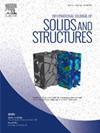二阶孔弹性的混合变分公式和有限元实现
IF 3.4
3区 工程技术
Q1 MECHANICS
International Journal of Solids and Structures
Pub Date : 2024-09-10
DOI:10.1016/j.ijsolstr.2024.113055
引用次数: 0
摘要
我们提出了一种二阶孔弹性的变分公式,通过使用标准的拉格朗日插值函数,可以很容易地将其应用到有限元代码中。其出发点是以位移和流体通量为自变量的两场最小化原理。以这一原理为基础,可以推导出以一组扩展自变量为基础的连续和增量鞍点公式。然后,通过静态压缩,将该公式简化为以位移和流体通量以及相关高阶场为单位的最小化原理。一旦将其应用于有限元代码,就可以在考虑二阶效应的情况下对多孔介质进行数值模拟。在此,我们通过几个例题分析了模型的响应,包括两个标准的孔弹性测试,即 Terzaghi 和 Mandel 的固结问题,并将结果与相应的一阶模型进行了比较。显而易见,当二阶模型用于研究空间尺寸与其微观结构尺寸相当的多孔介质时,可以充分发挥其潜力。特别是,它能够正则化外表面和内表面的陡峭场梯度,并能描述实验中已知的材料膨胀效应。本文章由计算机程序翻译,如有差异,请以英文原文为准。
Mixed variational formulation and finite-element implementation of second-order poro-elasticity
We present a variational formulation of second-order poro-elasticity that can be readily implemented into finite-element codes by using standard Lagrangian interpolation functions. Point of departure is a two-field minimization principle in terms of the displacement and the fluid flux as independent variables. That principle is taken as a basis for the derivation of continuous and incremental saddle-point formulations in terms of an extended set of independent variables. By static condensation this formulation is then reduced to a minimization principle in terms of the displacement and fluid flux as well as associated higher-order fields. Once implemented into a finite-element code, the resulting formulation can be applied to the numerical simulation of porous media in consideration of second-order effects. Here, we analyze the model response by means of several example problems including two standard tests in poro-elasticity, namely the consolidation problems of Terzaghi and Mandel, and compare the results with those of a corresponding first-order model. As becomes clear, the second-order formulation can unleash its full potential when applied to the study of porous media having spatial dimensions comparable to the size of their microstructure. In particular, it is capable to regularize steep field gradients at external as well as internal surfaces and to describe material dilatation effects known from experiments.
求助全文
通过发布文献求助,成功后即可免费获取论文全文。
去求助
来源期刊
CiteScore
6.70
自引率
8.30%
发文量
405
审稿时长
70 days
期刊介绍:
The International Journal of Solids and Structures has as its objective the publication and dissemination of original research in Mechanics of Solids and Structures as a field of Applied Science and Engineering. It fosters thus the exchange of ideas among workers in different parts of the world and also among workers who emphasize different aspects of the foundations and applications of the field.
Standing as it does at the cross-roads of Materials Science, Life Sciences, Mathematics, Physics and Engineering Design, the Mechanics of Solids and Structures is experiencing considerable growth as a result of recent technological advances. The Journal, by providing an international medium of communication, is encouraging this growth and is encompassing all aspects of the field from the more classical problems of structural analysis to mechanics of solids continually interacting with other media and including fracture, flow, wave propagation, heat transfer, thermal effects in solids, optimum design methods, model analysis, structural topology and numerical techniques. Interest extends to both inorganic and organic solids and structures.

 求助内容:
求助内容: 应助结果提醒方式:
应助结果提醒方式:


